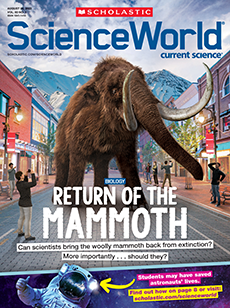This lizard may look like it’s floating, but it’s not! A tiny tangle-web spider has actually hoisted the reptile into the air—even though it’s 8,000 times heavier than the spider! These arachnids stretch crisscrossing lines of silk from their webs to the ground. When an animal gets tangled in the stretchy strands, the web breaks away from the ground and springs upward, lifting the spider’s prey so it can’t escape.
Tangle-web spiders hunt animals like insects, lizards, mice, and snakes—some of which can weigh thousands of times more than the spiders. Recently, materials scientists at the University of Trento in Italy discovered the mechanics behind the spiders’ ability to lift such heavy loads.
In their lab, Gabriele Greco and Nicola Pugno set up boxes each containing a tangle-web spider. Then the team placed an orange-spotted cockroach, which weighed many times more than one of the spiders, in each box. The cockroach eventually wandered into the spider’s web, but the cockroach’s hefty weight was too much for the web strands to lift the insect. So the spider rushed to attach more silk threads from its web to the cockroach. Each thread added a little more upward force, until it was enough to heave the roach skyward. “You can lift the weight of anything if you repeat the cycles enough,” says Pugno.
As for the lizard? While it struggled in the sticky web, the spider gave it a venomous bite to paralyze it, or make it unable to move. The spider also injected its catch with gastric juices to break down the lizard’s insides. The spider then sucked out the goo, leaving the outside of the lizard intact—still hanging in midair.
